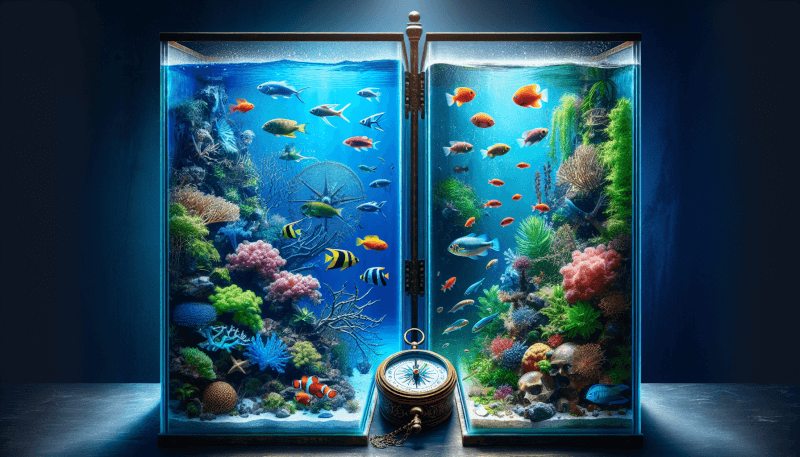Have you ever wondered about the visual differences between saltwater and freshwater aquariums? In this article, we will explore the aesthetics of these two types of aquariums, comparing their unique features and helping you decide which one might be best suited for your home or office. From the vibrant colors and diverse marine life of saltwater tanks to the serene and calming atmosphere of freshwater setups, we will delve into the visual appeal of both options, ultimately revealing their distinct aesthetic qualities. So, whether you’re a seasoned aquarium enthusiast or just beginning your journey into the world of fishkeeping, join us as we explore the captivating aesthetics of saltwater versus freshwater aquariums.

Benefits of Saltwater Aquariums
Saltwater aquariums offer numerous benefits that make them an attractive option for aquarium enthusiasts. One of the most notable advantages is the greater variety of color and pattern in marine life. Saltwater fish and invertebrates come in a wide range of vibrant colors and intricate patterns that create a visually stunning display. From the vivid blues and yellows of tangs to the striking reds and purples of corals, a saltwater aquarium can be a mesmerizing feast for the eyes.
Another benefit of saltwater aquariums is the ability to replicate a natural coral reef environment. With the right equipment, such as live rocks and coral reefs, you can create an ecosystem that closely resembles the beauty and complexity of a natural underwater habitat. This not only provides a visually stunning display but also creates a more natural and enriching environment for the marine species you choose to keep.
Saltwater aquariums are also known for the unique and exotic marine species they house. From clownfish and seahorses to sea stars and corals, saltwater aquariums allow you to explore a whole new world of fascinating creatures. These species are often sought after for their striking colors, unique shapes, and interesting behaviors. By keeping a saltwater aquarium, you have the opportunity to own and observe these captivating creatures up close.
In addition, saltwater aquariums offer enhanced visual depth and dimension compared to their freshwater counterparts. The combination of the vibrant colors, intricate structures, and various species creates a three-dimensional effect that adds depth and realism to the aquatic landscape. This creates a captivating and immersive experience for both the hobbyist and anyone who admires the aquarium.
Benefits of Freshwater Aquariums
While saltwater aquariums have their own appeal, freshwater aquariums also come with their own set of advantages. One of the most appealing aspects of freshwater aquariums is the more affordable setup and maintenance costs. The equipment and supplies needed for freshwater aquariums tend to be more budget-friendly, making them a more accessible option for those on a tighter budget or just starting out in the hobby.
Another benefit of freshwater aquariums is the wide variety of fish species available. With freshwater aquariums, you have a vast selection of fish to choose from, each with its own unique traits, colors, and behaviors. Whether you prefer the vibrant hues of tetras, the elegant grace of angelfish, or the playful nature of guppies, you are sure to find a freshwater fish species that suits your preferences and interests.
Furthermore, freshwater aquariums are generally simpler and easier to maintain compared to saltwater aquariums. The water chemistry and quality requirements are typically less demanding, resulting in a more forgiving environment for beginners or those with less experience in aquarium keeping. The lower maintenance demands of freshwater aquariums can also be advantageous for busy individuals or those who may not have as much time to dedicate to their aquarium.
Freshwater aquariums also offer the opportunity to incorporate colorful and vibrant freshwater plants into the aquatic setting. These plants not only add beauty and visual interest but also provide a natural filtration system and oxygenation for the fish. With a variety of aquatic plants to choose from, you can create a lush and vibrant underwater garden that complements the fish and enhances the overall aesthetics of the aquarium.

Tank Design and Equipment
When it comes to tank design and equipment, there are some considerations that differ between saltwater and freshwater aquariums.
For saltwater aquariums, the design focuses on creating a habitat that resembles a natural coral reef environment. The tank should have ample open space for swimming, as well as rocky structures, known as live rocks, which provide hiding places, surfaces for corals to attach to, and create a visually appealing aquascape. Additionally, a protein skimmer and a well-designed filtration system are essential to maintaining the water quality.
On the other hand, freshwater aquarium design considerations are more flexible and diverse. While some aquarists may opt for a more natural setup with rocks and driftwood, others may prefer a densely planted tank or a themed design. The tank should be designed to accommodate the chosen fish and plants, considering their size, swimming patterns, and compatibility. A reliable filtration system is necessary for removing waste and maintaining water quality in freshwater aquariums.
Different types of equipment are also needed for each type of aquarium. Saltwater aquariums often require additional equipment such as a quality protein skimmer, a powerful lighting system to support coral growth, and a specialized saltwater mix for water preparation. Freshwater aquariums typically require less specialized equipment, with a standard filtration system, lighting appropriate for the chosen plants, and a quality heater being the main requirements. Overall, the choice of equipment should be based on the specific needs of the fish and plants you plan to keep, as well as your budget and personal preferences.
Maintenance Requirements
Maintaining proper water quality and chemistry is crucial for the health and well-being of the inhabitants in both saltwater and freshwater aquariums. However, there are some key differences in the maintenance requirements for each type of aquarium.
In saltwater aquariums, maintaining stable water parameters is essential for the health of the coral reefs and marine life. This involves regular testing and adjusting of pH, salinity, and nutrient levels. Water changes, typically performed monthly, help to replenish essential trace elements and maintain optimal water conditions. Additionally, regular cleaning of the protein skimmer, filtration system, and removal of any detritus or excess algae is necessary to prevent the buildup of harmful substances.
In freshwater aquariums, water temperature and filtration are the primary maintenance considerations. It is important to monitor and regulate the water temperature to ensure it remains within the appropriate range for the fish species. Filtration systems should be regularly cleaned to prevent the accumulation of waste and maintain good water quality. Performing routine water changes helps to remove excess nutrients and maintain a stable ecosystem for the fish and plants.
Cleaning and maintenance routines also differ between saltwater and freshwater aquariums. In saltwater aquariums, the removal of excess algae and the cleaning of any live rocks or coral surfaces may be necessary to prevent competing organisms from overtaking the ecosystem. In freshwater aquariums, regular removal of debris, vacuuming the substrate, and trimming and pruning plants may be required to maintain a clean and aesthetically pleasing environment.
Feeding and nutritional needs of the fish also require attention in both saltwater and freshwater aquariums. Providing a balanced and varied diet that meets the specific requirements of the fish species is essential for their health and vitality. Regular observation of the fish’s behavior and appetite can help determine if any adjustments need to be made to their feeding schedule or diet.

Aquarium Decoration
The decorative elements in an aquarium play a crucial role in enhancing its visual appeal and creating a natural and aesthetically pleasing environment for the fish. The choice of aquarium decorations varies between saltwater and freshwater setups.
In saltwater aquariums, coral reefs and live rocks are popular choices for creating a natural and authentic underwater scene. These structures provide a habitat for various marine organisms, serve as anchor points for many coral species, and contribute to the overall stability and health of the ecosystem. Additionally, the vibrant colors and intricate shapes of corals and other sessile invertebrates add a unique and captivating element to the aquarium.
In contrast, freshwater aquariums often feature live or artificial plants as the main decorative element. Aquatic plants provide shelter, oxygenation, and nutrient uptake, creating a natural and visually appealing environment for the fish. The choice of plants can range from low-maintenance options like Java fern and Anubias to fast-growing stem plants like Hornwort and Ludwigia. By selecting a variety of plant species with different leaf shapes and shades of green, you can create a dynamic and harmonious aquascape.
For those who prefer artificial decor or want to add additional elements to their aquarium, there are options available for both saltwater and freshwater setups. Artificial corals, rocks, and ornaments can be used to enhance the visual appeal and mimic the look of a natural underwater environment in both types of aquariums. The key is to select decor that is safe for the fish and does not release any harmful substances into the water.
Compatibility of Fish and Invertebrates
When selecting fish and invertebrates for your aquarium, it is important to consider their compatibility with each other to create a harmonious and balanced aquatic community.
In saltwater aquariums, careful consideration of the interactions between different marine fish species is necessary to prevent aggression and territorial behavior. Some species may be more aggressive or territorial and may not coexist well with certain tank mates. It is essential to research the behavior and requirements of each species before introducing them into the aquarium. Similarly, keeping invertebrates such as shrimp and crabs requires careful consideration of their compatibility with other tank inhabitants, as some fish may see them as a food source.
In freshwater aquariums, compatibility between fish species is also important to maintain a peaceful community. Some species may be more aggressive or territorial, while others may be more sensitive to water conditions or require specific dietary needs. It is crucial to choose fish species that have similar temperaments, preferred water parameters, and feeding habits to ensure compatibility and reduce the risk of aggression or stress. Additionally, keeping invertebrates such as snails or shrimp can add interest and variety to the freshwater aquarium, but it is important to select species that are compatible with the chosen fish species.
Consideration should also be given to the overall community setup and compatibility. Some fish and invertebrates have specific social or environmental requirements, and not all species will coexist harmoniously. Researching the compatibility of different species and their specific needs is key to creating a thriving and peaceful community in both saltwater and freshwater aquariums.

Aquascaping Techniques
Aquascaping refers to the art of arranging rocks, driftwood, plants, and other elements in an aquarium to create visually appealing layouts and natural underwater environments. The techniques used in aquascaping vary between saltwater and freshwater aquariums.
In saltwater aquariums, the focus is on creating a natural underwater habitat that resembles a coral reef ecosystem. This involves arranging live rocks, coral fragments, and other structures in a way that creates hiding places, crevices, and swim-throughs for the fish and invertebrates. The use of different types of corals, in various shapes, sizes, and colors, adds to the complexity and visual interest of the aquascape. By mimicking the natural arrangement of elements in a coral reef, you can create a visually stunning and biologically rich environment.
In freshwater aquariums, aquascaping techniques can vary depending on the desired aesthetic and theme. Some aquarists choose to create a natural underwater garden by arranging rocks, driftwood, and plants to mimic a riverbed or a lakefront. Others may opt for a more structured layout with defined paths and focal points. The use of different types of plants, such as foreground plants, midground plants, and background plants, helps to create depth and visual interest. Incorporating driftwood and rocks not only adds a natural element but also provides hiding places and surfaces for algae growth and colonization by beneficial bacteria.
Overall, the goal of aquascaping is to create a visually appealing and harmonious layout that complements the chosen fish and plants in the aquarium. By combining different textures, shapes, and colors in a thoughtful and balanced way, you can create a captivating and immersive underwater world.
Lighting and Color Enhancement
Lighting plays a crucial role in both saltwater and freshwater aquariums, not only providing illumination but also enhancing the colors and overall aesthetics of the aquarium.
In recent years, LED lighting has become the standard choice for both types of aquariums. LED lights are energy-efficient, long-lasting, and customizable, allowing you to adjust the color spectrum and intensity to suit your needs. For saltwater aquariums, LED lighting can help promote the growth of corals, enhance the colors of the fish and invertebrates, and create a shimmering effect similar to natural sunlight. With freshwater aquariums, LED lighting can bring out the vibrant colors of the fish and plants, allowing you to fully appreciate their natural beauty.
The use of different light spectrums can further enhance the colors of the fish and plants in both saltwater and freshwater aquariums. For example, blue lights can bring out the fluorescent colors of corals and marine fish, while red lights can enhance the red and orange hues of certain freshwater fish species. Adjustable lights that allow you to simulate sunrise and sunset can also create a more natural and dynamic lighting cycle for the aquarium.
It is important to note that lighting can directly impact the growth and health of corals in saltwater aquariums. Corals require specific light spectrums and intensities to carry out photosynthesis and thrive. Researching the lighting requirements of the chosen coral species and selecting the appropriate lighting system is crucial to their long-term success.

Challenges and Risks
While both saltwater and freshwater aquariums offer rewarding experiences, it is essential to be aware of the challenges and risks involved in maintaining these aquatic ecosystems.
Saltwater aquariums, in particular, can be more demanding and require a higher level of maintenance and expertise. Maintaining stable water parameters, such as salinity and pH, can be challenging, especially for beginners. The delicate balance of an ecosystem in a saltwater aquarium means that even small fluctuations in water chemistry can have significant impacts on the health of the marine life. Additionally, saltwater aquariums are more prone to the buildup of algae and the presence of pests and parasites, requiring regular monitoring and intervention.
Freshwater aquariums also have their own challenges, although they are generally considered more beginner-friendly. One of the common challenges in freshwater aquariums is managing and preventing the overgrowth of algae, which can negatively impact the aesthetic appeal and water quality. Additionally, some freshwater fish species may be prone to certain diseases or parasites, requiring proper quarantine and care to prevent outbreaks. Maintaining water quality and temperature stability are also important considerations, as fluctuating conditions can stress the fish and impact their overall health.
Handling aggression and territorial behavior can be a challenge in both saltwater and freshwater aquariums. Certain fish species may exhibit aggressive tendencies towards tank mates, requiring careful selection and monitoring to ensure compatibility. Aggression can lead to stress, injury, and even death of the fish, so it is important to be aware of the compatibility and behavior of the chosen species.
Personal Preferences and Goals
When deciding between a saltwater or freshwater aquarium, personal preferences and goals play a significant role in making the right choice. Understanding your interests, level of commitment, and the resources you are willing to dedicate to your aquarium will help guide your decision-making process.
Choosing the right type of aquarium based on personal interests is crucial for long-term enjoyment. If you are captivated by the vibrant colors and unique species of the ocean, a saltwater aquarium may be the best fit for you. On the other hand, if you are drawn to the natural diversity and lushness of freshwater ecosystems, a freshwater aquarium may be more appealing. Consider researching the specific fish and invertebrates available in each type of aquarium to determine which aligns more with your interests.
Balancing aesthetics and practicality is another important consideration when designing your aquarium. While a visually stunning aquarium can create a focal point and add beauty to your home or office, it is essential to ensure that the setup is practical and manageable. Take into account the time, effort, and resources required to maintain and care for the aquarium and select a design that aligns with your lifestyle and commitment level.
Considering the long-term commitment and dedication required is crucial before embarking on the journey of aquarium keeping. Both saltwater and freshwater aquariums require regular maintenance, monitoring, and care to ensure the health and well-being of the inhabitants. Having a clear understanding of the long-term commitment and being prepared to allocate the necessary time and resources is key to creating a successful and thriving aquarium.
In conclusion, both saltwater and freshwater aquariums offer their own unique benefits and challenges. Saltwater aquariums captivate with their greater variety of color and pattern, the ability to replicate a natural coral reef environment, the presence of unique and exotic marine species, and enhanced visual depth and dimension. Freshwater aquariums, on the other hand, attract with their more affordable setup and maintenance costs, wide variety of fish species available, simplicity and ease of maintenance, and the opportunity to incorporate vibrant freshwater plants.
Whether you choose a saltwater or freshwater aquarium, careful consideration of tank design and equipment, maintenance requirements, aquarium decoration, compatibility of fish and invertebrates, aquascaping techniques, lighting, and the challenges and risks involved is necessary for creating a thriving and visually appealing aquatic environment. Evaluating your personal preferences, goals, and long-term commitment will guide you in making the right choice for your aquarium journey. Both saltwater and freshwater aquariums offer unique experiences and rewards, allowing you to immerse yourself in the fascinating world of aquatic life.


